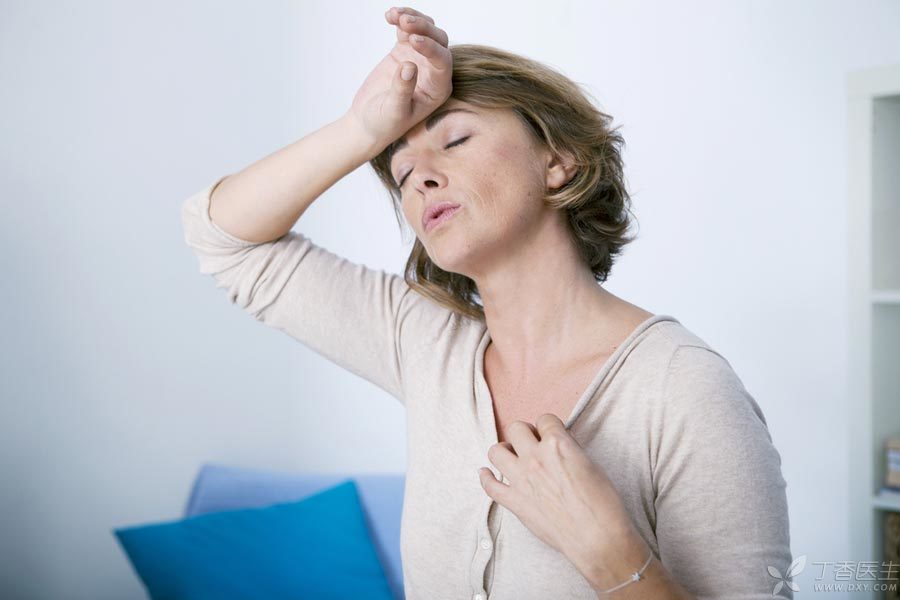hot flash
SYMPTOMS
What are hot flashes?
Hot flashes are a subjective symptom caused by endocrine dysfunction leading to thermoregulatory imbalance. They may occur as a normal physiological manifestation during perimenopause or result from gonadectomy or endocrine disorders, associated with abnormal levels of endogenous opioids, catecholamines, and sex hormones.
Typical symptoms include facial and neck flushing, often accompanied by sensations of heat, anxiety, and palpitations. Some individuals may also experience profuse sweating, chills, or shivering.
Hot flashes initially manifest as an increase in skin temperature, followed by a drop in core body temperature. The overall effect is not the release of accumulated body heat but rather a dysfunction in the heat dissipation mechanism. In most cases, hot flashes begin in the face or chest and then spread throughout the body. Some individuals may exhibit noticeable facial flushing during episodes.
Hot flashes often occur at fixed times, most frequently in the afternoon, and typically last no longer than 20–30 minutes. The frequency varies—some experience several episodes a day, while others may have them a few times a week or even hourly. Weather and ambient temperature can exacerbate symptoms.
Individuals experiencing hot flashes may also face emotional distress. While focusing on symptom relief, it’s important to address emotional well-being. Lifestyle changes such as meditation and exercise can help improve mood, and counseling may assist in resolving emotional difficulties. Additionally, understanding and support from family and friends can greatly aid in emotional recovery.

TREATMENT
How to relieve hot flashes?
-
Eat more fruits, vegetables, soy products, milk, and other foods rich in dietary fiber and protein. Reduce the intake of fatty, sugary, and spicy foods to avoid worsening symptoms.
-
Exercise for at least half an hour daily to improve cardiovascular function, which can promote blood circulation and help alleviate hot flashes.
-
Menopausal women should avoid alcohol, coffee, tea, and other foods containing alcohol or caffeine.
-
Hot flash symptoms may worsen in summer. Wearing cotton clothing can help relieve discomfort.
-
Under a doctor's guidance, medications such as progesterone, gabapentin, venlafaxine, or hormone replacement therapy may be taken.
-
Women going through menopause should maintain emotional stability and avoid extreme mood swings.
DIAGNOSIS
Under what circumstances should hot flashes require a hospital visit? Which department should be consulted?
Hot flashes are a subjective symptom commonly experienced by menopausal individuals, patients who have undergone gonadectomy, or those with endocrine disorders. Generally, the body gradually self-adjusts to establish a new equilibrium, and hot flashes may resolve on their own. If hot flashes can be alleviated by lowering room temperature, adjusting clothing appropriately, managing emotions, maintaining a balanced diet, or engaging in moderate exercise, medication may not be necessary.
If hot flashes disrupt daily life and routines, it is advisable to seek medical attention from the general internal medicine, gynecology, or andrology department. For middle-aged individuals experiencing hot flashes and sweating—if menopausal factors are ruled out or drug therapy proves ineffective—prompt consultation with the psychiatry or psychology department is recommended.
POTENTIAL DISEASES
What Causes Hot Flashes?
The etiology of hot flashes is highly complex, likely involving interactions between sex hormones, catecholamines, endorphins, and other neurotransmitters, leading to dysfunction of the hypothalamic thermoregulatory center.
-
Perimenopausal hot flashes are very common: Declining gonadal function in menopausal individuals results in unstable reductions in estrogen and testosterone levels, triggering autonomic nervous system dysfunction and endocrine disturbances that manifest as hot flashes.
-
Gonadectomy can cause hot flashes: Hot flashes are closely linked to decreased circulating estrogen levels. 70% of men who undergo orchiectomy experience hot flashes, while menopausal women or those with bilateral oophorectomy exhibit rapid estrogen decline and subsequent hot flashes. Postpartum women with low estrogen levels are also more prone to hot flashes. The effectiveness of estrogen replacement therapy in alleviating symptoms further confirms the strong association between hot flashes and reduced estrogen levels.
-
Improper use of contraceptives may trigger hot flashes: Some women taking oral contraceptives irregularly or discontinuing them abruptly during continuous or sequential use may experience hot flashes, which often resolve after dosage adjustment.